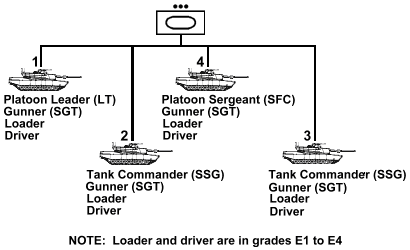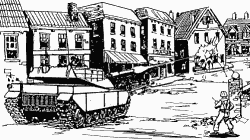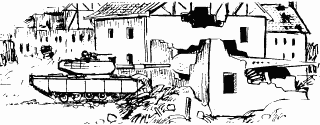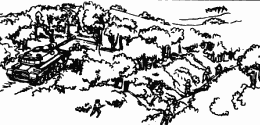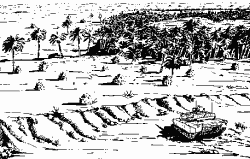Tank Platoon
The tank platoon is the smallest maneuver element within a tank company. Organized to fight as a unified element,
the platoon consists of four main battle tanks organized into two sections, with two tanks in each section.
Tank platoons usually operate as a whole or by section and do not normally deploy individual tanks.
The fundamental mission of the tank platoon is to close with and destroy the enemy.
The platoon's ability to move, shoot, communicate, and provide armored protection is a decisive factor on the modern battlefield.
It moves, attacks, defends, and performs other essential tasks to support the company team or troop mission.
In accomplishing its assigned missions, the platoon uses fire, maneuver, and shock effect, synchronized with other maneuver elements
and with combat support (CS) and combat service support (CSS) assets. When properly supported, it is capable of conducting sustained
operations against any sophisticated threat.
The tank platoon can survive and win in battle, however, only if it is well trained, effectively led, and highly motivated.
Crews must be aggressive, and their tactics must reflect the tempo and intensity of maneuver warfare. Platoon training must
prepare them to operate in hostile territory with the enemy to their front, flanks, and rear.
Tank Crew
The tank crew is a tightly integrated team. Though all members have primary duties, success depends on their effectiveness as a crew.
They must work together to maintain and service their tank and equipment, and they must function as one in combat.
Crews must cross-train so each member can function at any of the other crew positions.
- Platoon Leader
-
The platoon leader is responsible to the commander for the discipline and training of his platoon, the maintenance of its equipment,
and its success in combat. He must be proficient in the tactical employment of his section and of the platoon in concert with a company
team or troop. He must have a solid understanding of troop-leading procedures and develop his ability to apply them quickly and
efficiently on the battlefield.
The platoon leader must know the capabilities and limitations of the platoon's personnel and equipment; at the same time, he must be
well versed in enemy organizations, doctrine, and equipment. He must serve as an effective tank commander (TC). Most important of all,
the platoon leader must be flexible, using sound judgment to make correct decisions quickly and at the right times based on his
commander's intent and the tactical situation.
Platoon leaders must know and understand the task force mission and the task force commander's intent. They must be prepared to assume
the duties of the company commander in accordance with the succession of command.
- Platoon Sergeant
-
The PSG is second in command of the platoon and is accountable to the platoon leader for the training, discipline, and welfare of the
soldiers in the platoon. He coordinates the platoon's maintenance and logistics requirements and handles the personal needs of
individual soldiers. The PSG is the most experienced TC in the platoon. His tactical and technical knowledge allow him to serve as
mentor to crewmen, other NCOs, and the platoon leader. His actions on the battlefield must complement those of the platoon leader.
He must fight his section in concert with the platoon leader's section.
- Tank Commander
-
The TC is responsible to the tank platoon leader for the reporting of logistical needs and the tactical employment of his tank. He
briefs his crew, directs the movement of the tank, submits all reports, and supervises initial first-aid treatment and evacuation of
wounded crewmen. He is an expert in using the tank's weapon systems, requesting indirect fires, and executing land navigation.
The TC must know and understand the company mission and company commander's intent. He must be prepared to assume the duties and
responsibilities of the platoon leader or platoon sergeant in accordance with the succession of command. These requirements demand
that the TC maintain situational awareness by using all available optics for observation, by eavesdropping on radio transmissions,
and by monitoring the intervehicular information system (IVIS) or applique digital screen (if available).
- Gunner
-
The gunner searches for targets and aims and fires both the main gun and the coaxial machine gun. He is responsible to
the TC for the maintenance of the tank's armament and fire control equipment. The gunner serves as the assistant TC and assumes
the responsibilities of the TC as required. He also assists other crewmembers as needed. Several of his duties involve the tank's
communications and internal control systems: logging onto and monitoring communications nets; maintaining digital links if the tank
is equipped with the IVIS or applique digital system; inputting graphic control measures on digital overlays; and monitoring digital
displays during the planning and preparation phases of an operation.
- Driver
-
The driver moves, positions, and stops the tank. While driving, he constantly searches for covered routes and for covered positions
to which he can move if the tank is engaged. He maintains his tank's position in formation and watches for visual signals. If the
tank is equipped with a steer-to indicator, the driver monitors the device and selects the best tactical route. During engagements,
he assists the gunner and TC by scanning for targets and sensing fired rounds. The driver is responsible to the TC for the automotive
maintenance and refueling of the tank. He assists other crewmen as needed.
- Loader
-
The loader loads the main gun and the coaxial machine gun ready box; he aims and fires the loader's machine gun (if the vehicle is
equipped with one). He stows and cares for ammunition and is responsible to the TC for the maintenance of communications equipment.
Before engagement actions are initiated, the loader searches for targets and acts as air or anti-tank guided missile (ATGM) guard.
He also assists the TC as needed in directing the driver so the tank maintains its position in forma tion. He assists other
crewmembers as necessary. Because the loader is ideally positioned both to observe around the tank and to monitor the tank's digital
displays, platoon leaders and TCs should give strong consideration to assigning their second most experienced crewman as the loader.
If the function of loading the main gun is handled by an autoloader (no current U.S. tank has an autoloader), then loading of the
coaxial machine gun, as well as the stowage and care of ammunition, becomes the duty of the gunner. The absence of a loader also means
the TC assumes a greater degree of responsibility for air and ATGM watch.
Tank Capabilities and Limitations
Tanks offer an impressive array of capabilities on the modern battlefield. In combination, these factors produce the shock effect
that allows armor units to close with and destroy the enemy in most weather and light conditions.
Tanks can defend much like the infantry, but they are most effective when employed in a mobile situation that exploits their speed,
shock, and firepower. Tanks are most effective if the enemy is unaware of their presence and has planned to fight only against the
infantry forces that he has identified.
Tanks require extensive maintenance, proficient operators, and skilled mechanics, as well as daily resupply of large quantities
of bulky petroleum products such as fuel, oil, and grease.
- Mobility
-
Capabilities
-
The tank's mobility comes from its ability to move fast either on or off the road.
The ability to cross ditches; to ford streams and shallow rivers; and to push through small trees (up to 12 inches in diameter),
vegetation, wire obstacles, and limited obstructions allows tanks to move effectively in various types of terrain.
-
The addition of a mine plow enhances the tank's breaching capability, but also hinders movement in rough terrain.
-
Global positioning systems (GPS) and inertial position navigation (POSNAV) systems allow today's tanks
to move to virtually any designated location with greater speed and accuracy than ever before.
Limitations
-
Tanks are noisy. Therefore, there is little chance of them arriving in an area undetected.
-
During cold weather or when thermal nightsights or radios are used, the tank's engine must be run at least 30 minutes every
2 to 4 hours to keep the tank's batteries charged.
-
Because tanks lack bridging equipment, they can only cross bodies of water less than 4 feet deep.
-
Reconnaissance parties must ascertain the weight-supporting capacity of roads, bridges, and building floors to determine if they
can support the weight of tanks and other armored vehicles.
- Firepower
-
Capabilities
-
The best anti-tank weapon on the battlefield is the tank.
The tank's main gun is accurate and lethal at ranges out to 2,500 meters.
The stabilized gun allows effective fires even when the tank is moving cross-country.
-
The various machine guns provide a high volume of suppressive fires for self-defense and provide supporting fires for the infantry.
Limitations
-
Tanks cannot elevate or depress their main guns enough to engage targets very close to the vehicle or those high up in tall buildings.
-
Due to the length of the tank main gun, the turret will not rotate if a solid object is encountered, for example, a wall, post, and so forth.
-
Tank cannons create an overpressure and noise hazard to exposed infantrymen.
-
When the tank main gun fires, it creates a large fireball and smoke cloud. In the confines of an urban area, dirt and masonry
dust are also picked up and add to this cloud. The smoke and dust of the explosion further obscure the target. Depending on
local conditions, this obscuration could last as long as two or three minutes.
- Target Acquisition
-
Capabilities
-
The tank's ability to acquire targets exceeds that of all other infantry battalion systems.
On-board optics and sighting systems enable the crews to acquire and destroy enemy tanks, armored vehicles,
and fortifications using the main gun or to use machine guns to suppress enemy positions, personnel, and lightly armored targets.
The thermal sights on armored vehicles can detect enemy activity through darkness and smoke, conditions that limit even the
best-equipped infantry.
Limitations
-
Armored vehicle crews, especially those in tanks, are blind to infantry soldiers near their vehicle.
This limitation is worse during limited visibility or when the hatches are closed. This causes the crew to focus on the
enemy or on potential enemy locations rather than on friendly infantry moving close to the vehicle.
Fighting with closed hatches reduces the crew's ability to see, acquire, and engage targets.
Crewmen inside armored vehicles have poor all-round vision through their vision blocks; they are easily blinded by smoke or dust.
-
Because of the abundance of cover and concealment in urban terrain, armored vehicle gunners may not be able to easily identify
enemy targets unless the commander exposes himself to fire by opening his hatch or infantrymen directing the gunner to the target.
-
Dust, fires, and thick smoke significantly degrade a tank's thermal sights.
- Protection
-
Capabilities
-
The tank provides excellent protection. Across the frontal 60-degree arc, the tank is safe from all
weapons except heavy anti-tank missiles or guns and the main gun on enemy tanks.
-
When fighting with the hatches closed, the crew is safe from all small-arms fire, artillery rounds (except direct hits),
and antipersonnel mines.
-
The tank's smoke grenade launcher and on-board smoke generator provide fast concealment from observation (other than by thermals).
-
The tank's size and armor can provide dismounted infantry cover from direct-fire weapons and fragments. With coordination,
tanks can provide moving cover for infantrymen as they advance across small open areas.
-
The tank's smoke grenade launchers may be used both to protect the tank from enemy fire and to provide concealment for the
friendly infantry forces as they either move across open areas or recover wounded.
Limitations
-
Tanks are vulnerable to the weapons effects of other tanks, attack helicopters, mines, ATGMs, anti-tank guns, and close attack aircraft.
-
The tank's top, rear, and flank is vulnerable to lighter anti-tank weapons and (especially) to handheld anti-tank weapons.
The top is also vulnerable to precision-guided artillery or air-delivered munitions. Anti-tank mines can destroy or disable the vehicle.
-
Enemy fire striking a tank but not penetrating is a major threat to nearby infantry. Fragmentation that is generated by
anti-tank rounds and ricochets off tank armor have historically been a prime cause of infantry casualties while working
with tanks in urban areas.
-
The use of smoke must be carefully coordinated. Although the tank's sights can see through most smoke, friendly infantrymen are
at a significant disadvantage when enveloped in dense smoke clouds. The smoke grenade launchers on the tank provide excellent,
rapidly developed local smoke clouds, but the grenades produce burning fragments that are hazardous to infantrymen near the
tank and that can ignite dangerous fires in urban areas.
- Communications
-
Capabilities
-
Use of visual signals and the single channel ground/airborne radio system (SINCGARS) facilitates rapid and
secure communication of orders and instructions. This capability allows tank crews to quickly mass the effects of their weapon
systems while remaining dispersed to limit the effects of the enemy's weapons.
Limitations
-
Communication between the infantry on the ground and the crewmen on the tank is difficult. Voice communication
with any tank crew while a tank engine is ruining is restricted to shouting at the TC or climbing up to talk to him. In either
case, the infantryman has to get the attention of the tank commander first. Unplanned visual signals may work, but it is better
to use preplanned signals. Short of these measures, the dismounted infantry and armored forces must communicate by FM radio.
Tanks In Urban Areas
Tank-heavy forces could be at a severe disadvantage during urban combat, but a few tanks working with the infantry can be very
effective, especially if they work well together at the small-unit level. Tank, infantry, and engineer task forces are normally
formed to attack a fortified area. Individual tanks or pairs of tanks can work together with rifle squads or platoons.
Tanks need infantry on the ground to provide security in urban areas and to designate targets.
The first and most fundamental lesson learned from recent operations in urban areas is the value of the fully integrated combined
arms team. There is no denying the value of light infantry forces during urban combat. However, urban combat never should be considered
a purely infantry task.
Fighting in urban areas is centered around prepared positions in houses and buildings. Such positions cover street approaches and are
protected by mines, obstacles, and booby traps. Therefore, bridges, overpasses, and buildings must be inspected and cleared of mines
before they are used.
Tanks need infantry support when the two elements are working together. Do not leave tanks alone because they are not prepared to
provide local security during the operation. Tanks are extremely vulnerable to dismounted attack when operating on urban terrain.
Tanks are most vulnerable and need local security when infantry are in the process of clearing buildings. Tanks must remain relatively
stationary for prolonged periods allowing threat AT teams to maneuver to a position of advantage.
The infantry normally leads movement through urban areas. The tanks follow and provide close overwatch. If the infantry discovers an
enemy position or encounters resistance, the tanks immediately respond with supporting fire to fix the enemy in place or suppress him
and allow the infantry to develop the situation. After sufficient time to develop the situation or conduct short-range reconnaissance,
the infantry squad leader directs the tank to move, if necessary, and identifies specific targets for the tank to engage.
Tanks can be used to carry ammunition, water, and other supplies to support the urban fight.
If fields of fire are restricted to streets, hull-down positions should be used to gain cover and fire directly down streets.
From those positions, tanks are protected and can move to alternate positions rapidly. Buildings collapsing from enemy fires are
a minimal hazard to the armored vehicle and crew.
At times, the tank platoon may be required to transport infantrymen on its tanks. This is done only when contact is not expected.
If the tank platoon is moving as part of a larger force and is tasked to provide security for the move, the lead section or element
should not carry infantry.
Tanks In The Jungle
Densely forested areas, where tree trunks are close and heavy above-ground root systems exist, may make movement difficult.
Thick stands of bamboo may slow or even stop tanks.
Many jungles exist in rugged mountainous areas which will impede tanks. Swamps, coastal river basins, and other areas intersected
by waterways pose obstacles to tanks because of their soft soil and frequent deep channels.
Rainy seasons (monsoons) cause rivers and streams to rise and become unfordable. Heavy rains may also cause damage to roads.
Because the tank's mobility is greatly restricted on jungle terrain, its role is different in the jungle than that on more open
terrain. Instead of rapid envelopments and deep penetrations, tanks primarily provide fire support for infantry in jungle fighting.
Tanks and mechanized infantry are often restricted by jungle terrain, but where they can be employed, they complement each other well.
For this reason, mechanized infantry and armored units are often teamed. The two most common uses of tank-infantry teams in the jungle
are for movements to contact and for convoy escorts.
Tanks can perform the following missions in the jungle:
- Support attacking infantry. In the movement to contact, infantry will normally lead, supported by tanks from overwatch
positions whenever the terrain permits. Terrain and vegetation will dictate distances between the forces, but the tanks should
be close enough to the infantry to be able to move forward quickly to provide immediate fire support. In the meeting engagement,
once the infantry makes contact, tanks move to the point of contact to provide direct fire support.
- Provide heavy fire support in the defense and conduct counterattacks. Tanks in the jungle defense are vulnerable to
infiltrators; consequently, all-round security and close coordination with infantry are essential.
- Support infantry in retrograde operations. Contrary to general practice, in jungle retrograde operations tanks will often
disengage first, covered by the infantry.
- Secure convoys and protect lines of communications and key facilities.
- Attack or defend against enemy armor.
Tanks In The Desert
Conditions in an arid environment can damage military equipment. Temperatures and dryness are major causes of equipment failure.
Wind action lifts and spreads sand and dust, clogging and jamming anything that has moving parts. Vehicles, sensors, and weapons
are all affected. Rubber components such as gaskets and seals become brittle, and oil leaks are more frequent.
While tracked vehicles are well suited for desert operations, track components require special care in the desert. Grit, heat, and
bad track tension accelerate track failure. Sprockets wear out quickly in sandy conditions. Track pins break more easily in high
temperatures and high temperatures also increase rubber/metal separation on road wheels. Proper track tension is critical, as loose
track is easily thrown and excessive tension causes undue stress on track components.
The tank cannon is affected in several ways by the desert. One is thermal bending, which is the uneven heating and cooling of a
gun tube due to ambient temperature changes. Modern tanks, like the Ml, have been designed to compensate for these factors. The
muzzle reference system (MRS) allows the crew to monitor any loss of gun sight relationship and to comet for any error using the
MRS update at regular intervals. Ml-series tanks are equipped with a thermal shroud, allowing for more even heating and cooling of
the gun tube. Both factors can greatly reduce the accuracy of a tank weapon system. By boresighting at regular intervals and constant
monitoring of the fire control system, the tank crew can maximize its readiness.
The desert offers excellent fields of fire. Tanks should be sited to take advantage of their long range and accuracy. Firing first
and accurately are the most important considerations in desert operations.
In the desert, hull and turret defilades for tactical vehicles are essential. This allows a defending force to take advantage of
their long-range weapon systems in the face of enemy fires. Dispersion and frequent moves are other survivability techniques that
can be used.
Because the desert is an outstanding environment for employing aircraft, forces fighting in the desert should be reinforced
with additional air-defense weapons.
